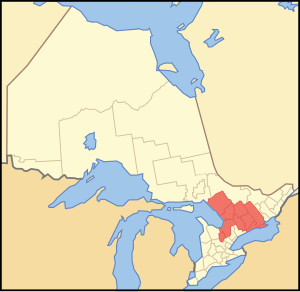Central Ontario

Central Ontario is the portion of the Canadian province of Ontario which lies between Georgian Bay and the eastern end of Lake Ontario.
The population of the region was 959,266 in 2001; however, this number does not include large numbers of seasonal residents, which at peak times of the year swell its population to well in excess of 1.5 million. Although it contains small urban centres, much of Central Ontario is covered by farms, lakes (with freshwater beaches), rivers or sparsely populated forested land on the southern edge of the Canadian Shield.
Definitions
Central Ontario is located entirely within Southern Ontario. It is not geographically close to the actual "centre" of Ontario as its name would suggest, but in the transitional area between Northern and Southern Ontario. Still, it is considered a sub-region of the south or billed as a "Gateway to the North."
Parry Sound District and Muskoka District are within Central Ontario, but are treated as part of Northern Ontario by federal economic development programs because of these districts' special economic circumstances; Parry Sound, but not Muskoka, is now classed with Northern Ontario by the provincial government.
All or part of Grey County and Bruce County may on occasion be included with Central Ontario as they are north of 44 degrees in latitude but are far more often treated as part of Western Ontario or the Georgian Triangle area, which includes parts of both Central and Western Ontario. Hastings County and Prince Edward County may be considered part of Central Ontario by different sources but are more often included as being in Eastern Ontario, mostly because they share the same telephone area code (613), have better transportation links to this region, and are part of the coverage area of Kingston-area media.
The southern portion of the region is mostly agricultural land mixed with wooded areas, together with the growing cities of Barrie and Peterborough. Both cities serve as regional centres with strong economic ties to the Greater Toronto Area due to their proximity to its outer fringes. Barrie in particular has a fast growing population as a result of the GTA's northern encroachment and has benefited economically from its key position as a gateway to the north. Both Barrie and Peterborough also overlap into the Greater Golden Horseshoe region.
Geography
The Canadian Shield runs over the northern part of Central Ontario, a recreational area with a much increased summer-time population, including the wilderness of Algonquin Provincial Park. Often referred to as 'Cottage Country', this area's lakes and rivers are dotted with numerous cottages, some of them seasonal, but in recent years there is a growing trend for some of these 'summer cottages' to be used as year-round residences due to a number of factors, abundance of outdoor recreation, baby-boom retiree population, increased local services and improved wireless communication.
The Trent-Severn Waterway, constructed over many years in the mid-19th century, spans Central Ontario via a series of boat locks, connecting Georgian Bay with Lake Ontario, entering the bay at Port Severn and Lake Ontario at the Trent River in Trenton. Bypassing many rapids, this world renowned waterway is used by pleasure boaters and anglers during the summer months.
Along the northern edge of Central Ontario, are some of the highest elevations in Southern Ontario. These highlands are known as the Opeongo Hills, and they stretch into portions of Eastern Ontario as well.
Climate
The climate of this area is a Humid continental climate with large seasonal variation moderated somewhat by the Great Lakes. Summers are warm and humid (sometimes hot) but are shorter than further south with generally cooler nights. Winters are cold with significant snowfalls; some snowbelt areas receive an average of over 300cm (120 in.) per year. Severe summer storms are also commonplace, particularly in Simcoe County which for Ontario has a high tornado prevalence and was the site of the infamous Barrie Tornado in 1985.
